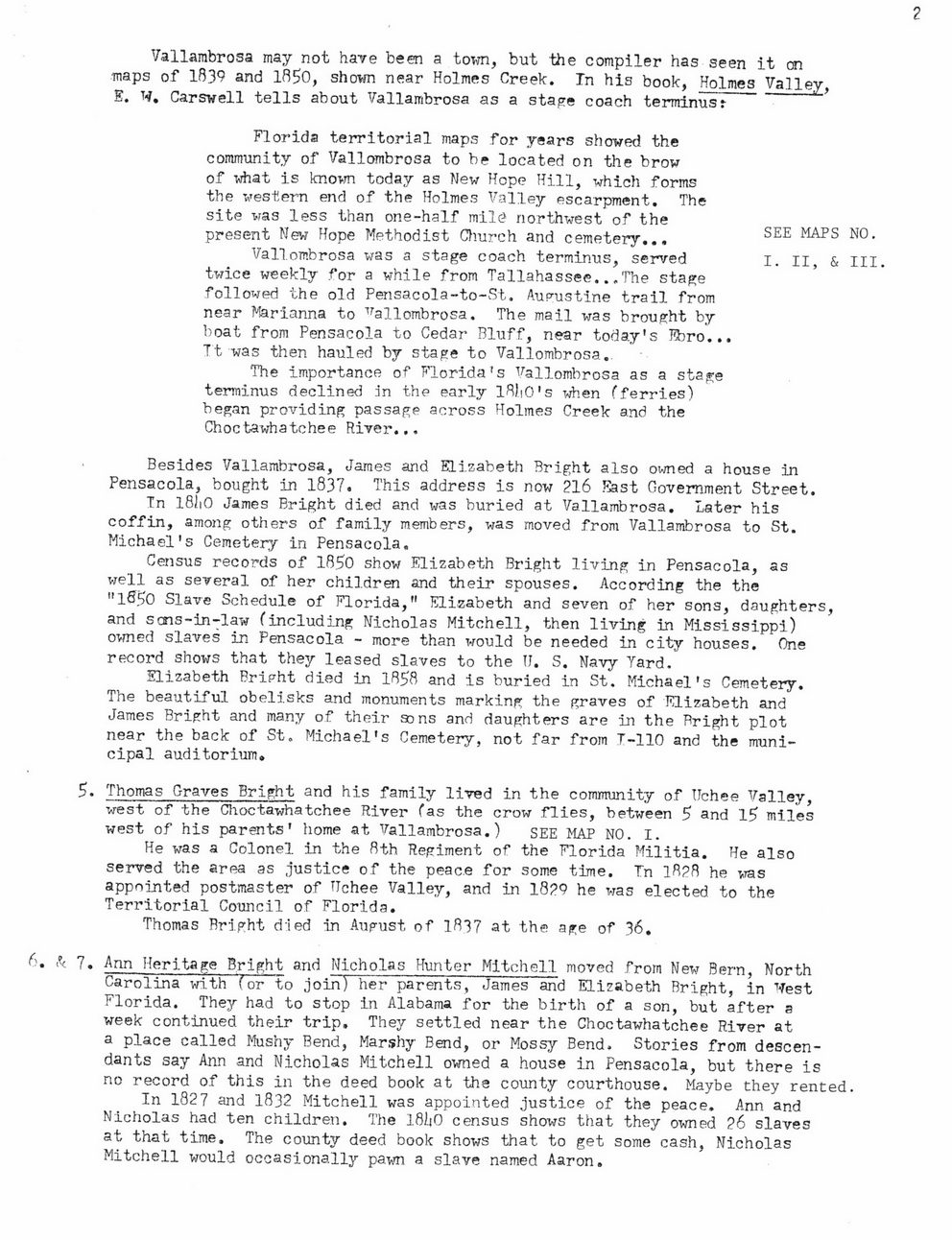This text was obtained via automated optical character recognition.
It has not been edited and may therefore contain several errors.
2 Vallambrosa may not have been a town, but the compiler has seen it cm maps of 1839 and 1850, shown near Holmes Creek. Tn his book, Holmes Valley, E. W, Carswell tells about Vallambrosa as a stage coach terminust Florida territorial maps for years showed the community of Vallombrosa to be located on the brow of what is known today as New Hope Hill, which forms the western end of the Holmes Valley escarpment. The site was less than one-half mile? northwest of the present New Hope Methodist Church and cemetery... SEE M^ps N0, Vallombrosa was a stage coach terminus, served I. 11, & m. twice weekly for a while from Tallahassee.The stage followed the old Pensacola-to-St. Augustine trail from near Marianna to Vallombrosa. The mail was brought by boat from Pensacola to Cedar Bluff, near today's Ebro... Tt was then hauled by stage to Vallombrosa. The importance of Florida's Vallombrosa as a stage terminus declined in the early I8!i0's when (ferries) began providing passage across Holmes Creek and the Choc tawhatehee River... Besides Vallambrosa, James arid Elizabeth Bright also owned a house in Pensacola, bought in 1837. This address is now 216 East Government Street. Tn I8I1O James Bright died and was buried at Vallambrosa. Later his coffin, among others of family members, was moved from Vallambrosa to St. Michael's Cemetery in Pensacola. Census records of 1850 show Elizabeth Bright living in Pensacola, as well as several of her children and their spouses. According the the "lff.S'O Slave Schedule of Florida," Elizabeth and seven of her sons, daughters, and sens-in-law (including Nicholas Mitchell, then living in Mississippi) owned slaves in Pensacola - more than would be needed in city houses. One record shows that they leased slaves to the Tl. S. Navy Yard. Elizabeth Bright died in 1858 and is buried in St. Michael's Cemetery. The beautiful obelisks and monuments marking the graves of Elizabeth and James Bright and many of their sons and daughters are in the Bright plot near the back of St. Michael's Cemetery, not far from T-110 and the municipal auditorium. 5. Thomas Graves Bright and his family lived in the community of TJchee Valley, west of the Choctawhatehee River (as the crow flies, between 5 and 15 miles west of his parents' home at Vallambrosa.) SEE MAP NO. I. He was a Colonel in the 8th Regiment of the Florida Militia. He also served the area as justice of the peace for some time. Tn l8?8 he was appointed postmaster of TTchee Valley, and in 18?9 he was elected to the Territorial Council of Florida. Thomas Bright died in August of 1837 at the age of 36. & 7. Ann Heritage Bright and Nicholas Hunter Mitchell moved from New Bern, North Carolina with (or to join) her parents, James and Elizabeth Bright, in West Florida. They had to stop in Alabama for the birth of a son, but after a week continued their trip. They settled near the Choctawhatehee River at a place called Mushy Bend, Marshy Bend, or Mossy Bend. Stories from descendants say Ann and Nicholas Mitchell owned a house in Pensacola, but there is no record of this in the deed book at the county courthouse. Maybe they rented. In 1827 and 1832 Mitchell was appointed justice of the peace. Ann and Nicholas had ten children. The 181(0 census shows that they owned ?6 slaves at that time. The county deed book shows that to get some cash, Nicholas Mitchell would occasionally pawn a slave named Aaron.

Mitchell Part-of-the-Bright-Family-Tree-with-Footnotes-part3